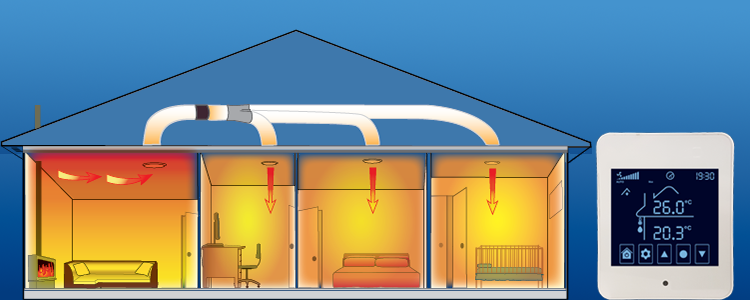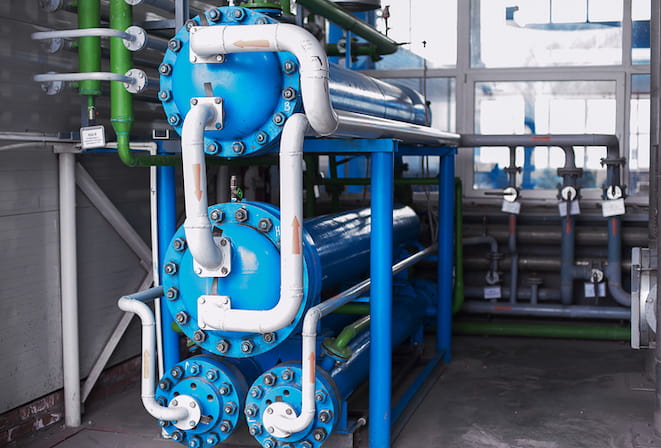Top 10 Thermal Innovations Driving DVS Heat Transfer Systems Forward
Wiki Article
Technologies in Heat Transfer Systems: What You Required to Know for Optimum Efficiency
Technologies in Heat transfer systems are changing efficiency throughout numerous industries. Advanced materials like graphene and nanofluids assure considerable renovations in thermal conductivity. At the same time, the integration of IoT and artificial intelligence supplies possibilities for real-time tracking and enhanced energy efficiency. The landscape of thermal monitoring is swiftly progressing. Comprehending these developments is vital for achieving perfect system performance and sustainability in the future. What specific innovations are shaping this change?Emerging Products for Improved Heat Transfer

Advanced Heat Exchanger Designs
While standard Heat exchangers have actually served their function in numerous applications, progressed styles are now arising to fulfill the enhancing needs for performance and performance. These innovative styles, such as plate, shell-and-tube, and finned-tube Heat exchangers, include enhanced area and enhanced circulation patterns to raise thermal transfer rates. Additionally, small styles enable lowered space requirements without jeopardizing efficiency. Advanced products, such as compounds and corrosion-resistant alloys, furthermore improve sturdiness and efficiency under severe problems. In addition, simulation modern technologies and computational fluid dynamics are progressively utilized to fine-tune these layouts, ensuring peak Heat transfer characteristics. As sectors look for to lessen power usage and maximize output, the fostering of innovative Heat exchanger styles is crucial in attaining these purposes.The Function of Nanotechnology in Heat Transfer
Nanotechnology plays a vital role in enhancing thermal conductivity within Heat transfer systems. By controling materials at the nanoscale, scientists have accomplished considerable improvements in power effectiveness. These developments not just enhance performance yet likewise add to more lasting energy solutions.Boosted Thermal Conductivity
Considerable improvements in thermal conductivity have arised with the application of nanotechnology, revolutionizing Heat transfer systems across numerous industries. By including nanoparticles into Heat transfer liquids and materials, scientists have accomplished remarkable boosts in thermal conductivity. These nanoparticles, such as carbon nanotubes, graphene, and steel oxides, improve the Heat transfer properties because of their high area and distinct thermal features. The resulting composites display boosted performance in applications ranging from electronic devices cooling systems to renewable energy modern technologies. Moreover, the capacity to customize the size, shape, and structure of nanoparticles permits maximized thermal management services. Therefore, nanotechnology remains to play a critical duty in the growth of much more effective and reliable Heat transfer systems, leading the means for enhanced industrial applications.
Energy Effectiveness Improvements

Assimilation of IoT in Heat Transfer Systems
The assimilation of IoT in Heat transfer systems presents the execution of wise sensors that enhance functional effectiveness. These sensors enable real-time information tracking, permitting instant changes and optimizations. This technological development has the potential to considerably improve efficiency and power administration in Heat transfer applications.Smart Sensors Application
As Heat transfer systems evolve, the combination of clever sensors via the Internet of Points (IoT) has emerged as a transformative technique. These sensors allow real-time surveillance of flow, temperature level, and stress prices, enhancing system performance and dependability. By accumulating and transmitting data, they promote proactive upkeep, lowering the risk of system failures. Furthermore, clever sensors contribute to energy cost savings by refining functional parameters based on environmental conditions. Their capability to examine anomalies and trends enables notified decision-making, making certain peak performance of Heat transfer systems. As markets progressively embrace this modern technology, the implementation of smart sensors stands to revolutionize how Heat transfer systems are managed, paving the way for greater sustainability and improved performance outcomes.Real-Time Information Monitoring
How can real-time information monitoring enhance the efficiency of Heat transfer systems? By incorporating Net of Points (IoT) innovation, Heat transfer systems can utilize continual data collection from wise sensors. This real-time tracking permits immediate analysis of flow, pressure, and temperature level rates, allowing operators to recognize inadequacies immediately. Adjustments can be made to enhance efficiency, decrease power usage, and extend DVS Heat Transfer Systems tools lifespan. In addition, predictive upkeep can be carried out, reducing unanticipated downtime and costly fixings. The capability to envision performance metrics via dashboards improves decision-making, cultivating a positive strategy to system management. Eventually, real-time information keeping an eye on not just improves functional performance but likewise adds to sustainability goals within commercial procedures.Energy Effectiveness and Sustainability Trends
Power performance and sustainability trends are reshaping the landscape of Heat transfer systems, driving innovation and compliance throughout numerous industries. Organizations are progressively focusing on energy-efficient layouts to lower operational costs and lessen ecological influences. The integration of sustainable power resources is becoming much more common, making it possible for Heat transfer systems to run sustainably while satisfying regulatory needs. In addition, developments in technologies and materials promote lower energy usage and improve general performance. Lifecycle evaluations are likewise acquiring grip, allowing firms to examine the ecological impact of Heat transfer systems from manufacturing to disposal. This focus on sustainability not just supports company duty however also settings organizations competitively in a market where consumers increasingly prefer environment-friendly solutions. Subsequently, power efficiency and sustainability remain essential factors to consider for future advancements in Heat transfer innovation.Developments in Thermal Management Solutions
While the demand for effective Heat transfer proceeds to rise, advancements in thermal administration solutions are emerging to attend to both efficiency and sustainability obstacles. Advanced materials, such as phase change products and nanofluids, are being created to boost Heat transfer effectiveness - DVS Heat Transfer Systems. These materials enhance thermal conductivity and permit much better temperature policy in various applications. In addition, modern technologies like energetic thermal control systems are gaining traction, making it possible for real-time changes to take care of Heat flow efficiently. These systems add to power savings and lower the environmental impact of thermal procedures. The assimilation of IoT in thermal management facilitates surveillance and anticipating maintenance, guaranteeing optimized performance and longevity of Heat transfer systems. Generally, these advancements stand for considerable strides toward more sustainable thermal administration methodsFuture Directions in Heat Transfer Innovation
Emerging improvements in thermal management solutions indicate an appealing future for Heat transfer innovation. Researchers are progressively concentrating on establishing materials with premium thermal conductivity and improved energy performance. Developments such as nanofluids, which consist of put on hold nanoparticles, use substantial improvements in Heat transfer efficiency. Furthermore, the assimilation of smart products that adjust to varying temperature conditions is getting grip, permitting for more responsive and efficient systems. The rise of additive production methods is likewise making it possible for the style of complex Heat exchanger geometries that optimize liquid flow. The implementation of machine understanding algorithms is prepared for to change the optimization of Heat transfer systems, assisting in anticipating maintenance and efficiency enhancement. Collectively, these innovations are poised to change the landscape of Heat transfer modern technologies in numerous industries.
Regularly Asked Questions

Just how Do I Select the Right Heat Transfer System for My Application?
Selecting the appropriate Heat transfer system includes assessing application requirements, consisting of temperature arrays, liquid buildings, and performance needs. Assessing system kinds, maintenance considerations, and cost-effectiveness likewise plays a vital role in making an educated decision.What Are the Upkeep Requirements for Advanced Heat Exchangers?
Maintenance requirements for sophisticated Heat exchangers normally include regular evaluations, checking for leakages, cleaning of surfaces, and ensuring optimal flow rates. Sticking to maker standards assurances effective operation and lengthens the tools's lifespan.
Exactly How Do Environmental Elements Influence Heat Transfer Effectiveness?
Environmental variables significantly affect Heat transfer effectiveness. Variants in temperature, airflow, and humidity influence thermal conductivity and convective Heat transfer, inevitably influencing system efficiency and demanding consideration during the layout and procedure of Heat transfer systems.What Security Criteria Apply to Heat Transfer Equipments?
Security standards for Heat transfer systems typically include standards from organizations such as ASME and ASTM. DVS Heat Transfer Systems. These criteria address products, style, and functional practices to guarantee reliability, performance, and defense against hazards in various applications
Exactly How Can I Troubleshoot Usual Heat Transfer System Issues?
Fixing typical Heat transfer system concerns involves looking for leaks, ensuring correct fluid circulation, checking insulation integrity, and confirming temperature level differentials. Identifying these elements can help preserve system performance and avoid more difficulties.Nanotechnology plays a crucial function in boosting thermal conductivity within Heat transfer systems. Substantial developments in thermal conductivity have arised through the application of nanotechnology, revolutionizing Heat transfer systems across various industries. Developments in thermal conductivity with nanotechnology have actually paved the method for remarkable enhancements in energy performance within Heat transfer systems. Power effectiveness and sustainability patterns are reshaping the landscape of Heat transfer systems, driving technology and compliance throughout various markets. The assimilation of IoT in thermal administration promotes tracking and anticipating upkeep, ensuring optimized performance and long life of Heat transfer systems.
Report this wiki page